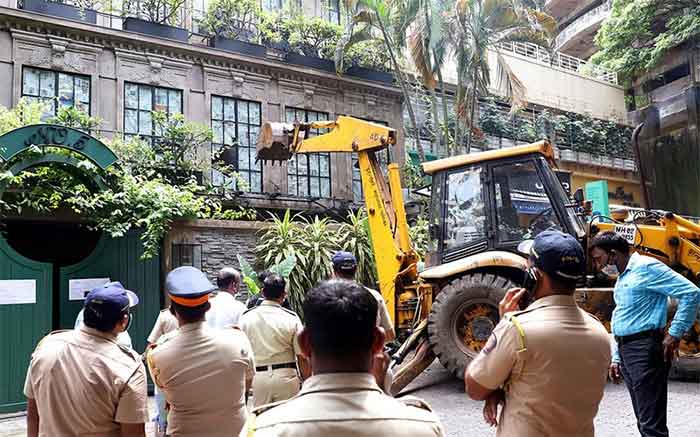
The controversial demolition of the allegedly illegal construction in film star Kangana Ranaut’s bungalow at Pali Hill in Bandra on September 9 should be seen in a broader perspective. The crux is that over the years there is a tacit understanding between sections in the State government, the municipal corporation and the rich about land grab and illegal construction, enjoying privilege.
Let us see how the conspiracy of the powers that be and rich citizens works against the poor. We take an example from Pali Hill itself. I live nearby and have observed this over the years. On the entire Pali Hill where film stars, big politicians and others live there is no footpath at all though the main road named after Nergis, the film star, is quite broad.
This completely violates civic norms and a fundamental right of mobility of common people who cannot walk with any safety because there is heavy, reckless motor car traffic. The tacit understanding is that if a footpath is provided, it will eliminate the free car parking enjoyed by the rich. This is a serious case of public land grab by the rich.
In the last forty years I have not heard one politician from this area or elsewhere arguing that the basic amenity of a footpath should be provided in this prime area. The hill is now converted into one big gated community where the poor have little access.. The collusion cuts across political lines.
The violation by Kangana is a drop in the ocean in a way considering that such transgressions occur all over the country in fact with the authorities often looking the other way. The demolitions take place selectively or when there is public outrage. A fire in an illegal restaurant in the Kamala mill compound in Mumbai three years ago in which several people were burnt to death led to demoltion of several illegal pubs, bars, eating joints of the rich.
The textile mill land grab by the rich in Mumbai was directly facilitated by collusion with the government and civic body. The original government regulation of giving one third of the mill land for public housing was diluted secretly. Those who should have spoken out did not. Architect Rahul Mehrotra was right in observing that this would not have happened had the civil society been vigilant.
The trouble is that the upper class urban activists are interested mainly in gentrification, they may appear to be doing good work by taking up green , environment causes but not a few are in collusion as well. Many are devoted to evict poor hawker from the street while they remain totally silent on the most blatant violations by malls and other commercial establishments, some of these are really fire traps.
The Maharashtra government deserves some sympathy in the overall context but the Shiv Sena’s administration in the municipal corporation in Mumbai will remain a major problem for it.
In one respect the BMC seems to live in the iron age, literally. On my morning walks I invariably come across a sanitation department woman worker pushing a cart with iron wheels.It makes a terrible, irritating noise. One can imagine the impact on the poor lady being exposed to it constantly. Yesterday, I made it a point to ask her if the wheels ever had rubber tyres. She said, no it has been always been like this.She says she gets a bad headache because of the constant noise. So, there are basic structural problems.Apparently, most politicians and bureaucrats have never heard of ergonomics which relates to design of workplaces, products and systems so that it is suitable for people using them.
Now, even parents and every one should learn about this because of the trend of work from home and more crucially making children use computers for class rooms while sitting in home. If we do not design properly for children they will face discomfort and long term consequences.
Because of extreme callousness regarding ergonomics and safety concerns in general our factories have a disastrous record of death and injuries in comparison with other countries. And now with further relaxation of industry and labour laws, there is going to be more suffering.
Formerly, there was a lot of awareness about industrial safety, Chandrakant Garware used to head the national safety council. There used to be seminars on the subject. Do our administrators even know the Central Labour Institute in Sion deals with this issue, or at least it used to. They would not miss it if they look out of their cars on the highway.
As for the BMC one is used to the rampant corruption and starkly visible building violations. At least it should not cause misery and destruction. In one garden I know the administration has in the last few days destroyed the greenery, instead of creating it, and turned large tracts into a desert .
Assaults by vested interests on Nature and on public spaces go on every where. Kingshuk Nag, my former colleage in the Times of India, writes about Hyderabad that at this rate the city will be soon without its rocks and hills and sans its lakes and greens. The over 450-year-old Hussain Sagar lake has shrunk to alarming levels. It is estimated that in the past 30 years, the lake has shrunk about 40 % of its original size (550 ha to 349 ha). The natural beauty of the city once bandied about as the ‘City of lakes’ will be replaced by huge concrete constructions and broad road. I am glad there is an organisation called Society to Save Rocks. It organises Rock Walks nature treks to different rocky areas in and around Hyderabad. They usually take place in the afternoon (and occasionally in the early morning) of the third Sunday of every month. No fees are charged.
And then look at the words of Ranjit Sabikhi, a veteran and socially conscious Delhi architect. He reserves most venom for what he calls the ‘babu culture’ of the city, in which the elite and the bureaucrats shun their responsibilities to build democratic spaces, instead using their power and influence to garner privileges. An example that he quotes is the New Moti Bagh or Netaji Nagar developments, built in 2007, where on a site of 110 acres, only 492 apartments were created for senior government officials-a blatant example of those in power cornering prime property in the city for their own benefit. At the same time, Sabikhi also speaks of how land allocations for the urban poor have been constantly reduced.
He does not make the point about land monetization. But some of our anti people bureaucrats have been always talking of selling government land to raise finances for projects. The usual false excuse is the government has no funds. Land monetization, land capture are the catch words for these worthies.Yet, a huge mass of 110 acres is used for a few bureaucrats. Can one imagine what it comes to in terms of sq ft. – more than 47 lakh sq ft. Why has one never heard an outcry on this before ? This is partly because of the conspiracy of silence on the part of the media, architects, engineers, planners. It would make a very good media story to find out how much sq ft area each bureaucrat enjoys.
This is deeply anti-democratic for another reason, it is rank bad land use planning. This is also a clever way to justify the use of motor cars. When you have such vast area in your gated colony, you are not likely to use public transport. Elite, progressive intellectuals in Delhi are unfortunately not taking up many serious urban issues with the urgency that is needed.
Vidyadhar Date is a senior journalist and author of a book on democratising transport, urban space
SIGN UP FOR COUNTERCURRENTS DAILY NEWSLETTER














































